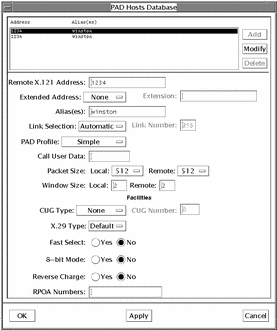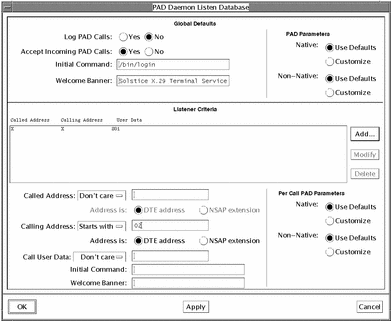Configuring the PAD
Once you have a working connection to a network, you can use it to make PAD calls using the PAD software delivered with the Solstice X.25 software.
Users can make PAD calls without you carrying out any configuration. However in order to do so, they need to know addressing and configuration information for their destination. You can use x25tool to create a database of remote hosts containing relevant addressing and configuration information. This lets users make calls using aliases instead of addresses.
You can also set up a database of parameters to be applied to incoming calls. This is particularly useful if you have a server that receives a large number of calls.
Configuring the PAD Hosts Database
To access the PAD Hosts Database, pull down the Services menu and choose PAD => PAD Hosts Database:
The PAD Hosts Database window looks like this:
Figure 6-3 PAD Hosts Database Window

To add an entry:
-
Click on Add.
-
Specify the X.121 Remote Address.
For a WAN link, this is the DTE address of the remote host. A valid DTE address has 15 or fewer decimal digits.
For a LAN link, this is the LSAP of the remote host. A valid LSAP (MAC plus SAP) address is 14 hexadecimal digits in length. In most cases, the last two digits of an LSAP address are 7e. You can use ARP-style notation, with colons separating the bytes within an LSAP address. Within a colon-delimited byte, you can omit a leading zero.
-
Type the name of the alias you want to use, if appropriate.
-
Add any Aliases you want to use to call this destination.
-
Set the Link Selection parameter to Automatic.
This uses the Solstice X.25 routing link selection feature. In some instances, you may want to specify the link number, instead (a link number of 255 indicates automatic link selection). This allows you to bypass routing specs, or to make certain that the specified link is always used.
-
Change any other relevant parameters.
In most cases you do not need to do this. Refer to "PAD Hosts Database" in Chapter 7, Parameter Reference for information on the other available parameters.
-
Click on OK to add the new entry to the database.
Configuring the PAD Daemon Listen Database
The PAD Daemon Listen Database determines how incoming PAD calls are handled. You can set global default values that are used for all incoming calls and optional values that apply to calls with particular characteristics. To access the PAD Hosts Database, pull down the Services menu and choose PAD => PAD Daemon.
The PAD Daemon Listen Database window looks like this:
Figure 6-4 PAD Daemon Listen Database

-
Configure the PAD Daemon Listen Database to log or not to log PAD calls.
When the Log PAD Calls option is set to Yes, information about each PAD call made is logged to the file /var/opt/SUNWconn/x25/x29serverlog. This file can become very large. If you have problems with disk space, check the x29serverlog file size and, if necessary, delete it.
-
Configure the PAD Daemon Listen Database to accept or not to accept incoming PAD calls.
If the Accept Incoming PAD Calls option is set to No, the system will not accept incoming PAD calls. The system can still make outgoing calls.
-
This is the message that someone logging in to this machine using a PAD call will see when the connection is made. It might be useful to give the machine name or any particular information about this machine that users need.
There are two Welcome Banner fields in the database window. The first is under the Global defaults. The second is displayed under the Listener Criteria. You can specify a Welcome Banner for a particular listener, or you can leave this field blank, in which case the default banner will be used.
If you don't want a Welcome Banner, enter a single space in the field for the global Welcome Banner.
-
This determines what happens when a user connects to this machine using a PAD call. The command /bin/login, which appears by default in this field, prompts for the user's name and password.
There are two Initial Command fields in the database window. The first is under the Global defaults. The second is displayed under the Listener Criteria. You can specify an Initial Command for a particular listener, or you can leave this field blank, in which case the default will be used.
If you don't want an Initial Command, enter a single space in the field for the global Initial Command.
-
Change the Listener Criteria, if necessary.
You can also set the parameters described above so that they are applied differently to certain calls. There are two ways to distinguish which calls they can apply to--using the Called Address and using the Calling Address.
The Called Address is the address of the local machine. If you use sub-addressing, a remote host can call the local machine using any one of these sub-addresses. You can configure the local machine to behave differently depending on the sub-address called--for example, on a machine with several applications, you could use a different sub-address to call each one, using a combination of the Called Address and Initial Command parameters to set this up.
The Calling Address is the address of the machine making the call, the remote machine. Again, you might want to use a different Initial Command, depending on where the call is from. You might also need to use different X.3 parameters if the remote host has a non-default configuration. To set the X.3 parameters, select Customize under PAD Call Parameters. For more information on X.3 parameters, see Chapter 7, Parameter Reference.
To set parameters applying to a particular Called Address, choose Matches and enter the exact address. To apply the parameters to a particular group of Called Addresses, use Starts With to affect all addresses starting in the same way, or Pattern to use wildcards such as an asterisk (*) or a question mark (?).
To set parameters applying to a particular Calling Address, choose Matches and enter the exact address. To apply the parameters to a particular group of Calling Addresses, use Starts With to affect all addresses starting in the same way, or Pattern to use wildcards.
To set parameters applying to calls using specific Call User Data, choose Starts With to affect all calls with CUD starting the same way and Matches to affect all calls using identical CUD. For more information on Call User Data, see Chapter 7, Parameter Reference.
- © 2010, Oracle Corporation and/or its affiliates
